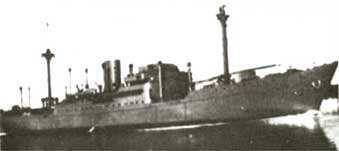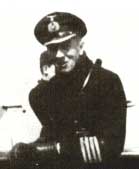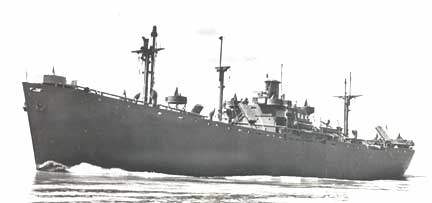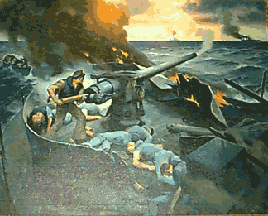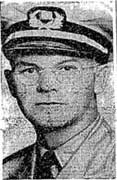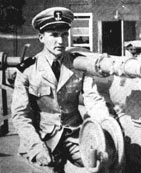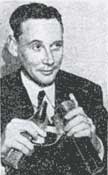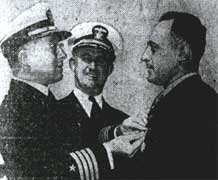The Gallant Liberty Ship SS Stephen Hopkins Sinks a German Raider
During World War II, the German Navy used heavily armed, converted merchant ships as "surface raiders" or "auxiliary cruisers" to prey on Allied shipping. These ships were usually disguised as neutral-flag cargo ships, but typically had two torpedo tubes forward, six 15cm (5.9-inch) guns, plus anti-aircraft guns. Most carried seaplanes and torpedo boats. They changed their profiles frequently through the addition of fake masts and stacks. Their guns were camouflaged as deck cargo or behind false deck panels.
False panels hide the Stier's guns Horst Gerlach, captain of the Stier The raider Stier, formerly the merchant ship Cairo, was built by Krupp in 1936, at 434 feet long, 56.5 feet broad, with a top speed of 14 knots. The Allied code name for her was "Raider J." She began operation as a raider in May 1942 under the command of Horst Gerlach, with a crew of 324 well-trained Navy men.
Her first three victims were: Gemstone (British), Stanvac Calcutta (Panama-flag U.S.-owned), and Dalhousie (British).
On the morning of September 27, 1942, the Stier was taking on supplies from the blockade runner Tannenfels off the coast of South Africa when she spotted a ship coming out of the mist not far away. It was the Liberty ship SS Stephen Hopkins, operated by the Luckenbach Steamship Co. out of San Francisco. Built by Kaiser Richmond No. 2, she was on her maiden voyage - San Francisco - Bora Bora - Auckland, New Zealand - Melbourne - Port Lincoln, Australia, Durban - Capetown - and bound in ballast for Paramaribo, Dutch Guiana.
A Liberty shipAt 9:30 AM that Sunday morning Captain Paul Buck, Chief Mate Richard Moczkowski, and George Papas, A.B., were on the bridge. Kenneth Vaughn, 3rd Assistant Engineer, Michael Fitzpatrick, fireman, and Andrew Tsignonis, wiper, were on watch in the engine room. Ford Stilson, the 32-year-old Chief Steward, heard a shot pierce the superstructure, then the general alarm. He grabbed his lifejacket and went to his battle station. He would set up a makeshift hospital in the officers’ mess.
The Armed Guard gunners and mariners assigned as loaders raced to their guns. Off the starboard bow, they saw a ship about the same size as the Hopkins firing at them. A larger ship was behind her. Explosions rocked the ship and machine gun fire was raking the decks. One of the first shells killed two mariners as they stepped on deck.
Moczkowski gave orders to steer so the stern of the ship - with its 4 inch gun - would continue to point at the enemy ship and at the same time present the smallest target.
Kenneth Willett, commander of the Armed Guard, was severely wounded in the abdomen by shrapnel, but he continued directing the men. Seaman Barker, in charge of the 4 inch gun, trained it directly at the waterline of the German raider, getting a shot off about every 45 seconds. They made every shot count, hitting the raider’s rudder and then damaging the raider’s forward guns.
In the forward tub, Wallace Breck, two other Armed Guard men, and Second Mate Joseph E. Layman, fired round after round at the smaller ship. All the guns aboard the Hopkins were firing as fast as they could be loaded and discharged. Hit after hit was scored on both enemy ships.
An enemy shell pierced the Hopkins' half inch steel hull, hitting directly in the engine room. Those above heard the explosion, then the roar of steam, as the black gang died at their posts.
A large caliber shell hit the forward gun tub just about the time the abandon ship signal was blown. Seaman Second Class Breck was the only survivor. He jumped overboard and climbed into a lifeboat, just as a shell hit the lifeboat, blowing it out of the water. Breck was the only survivor again.
The Stier was still putting shell after shell into the upper works of the Stephen Hopkins.The Tannenfels kept machine gunning the Hopkins. The Armed Guard fired their machine guns right back.
Cadet O’Hara saw the 4-inch gun deserted and dead men on the deck around it. O’Hara loaded and fired all 5 shells left in the ready box, scoring hits with all five. A few moments later he was killed by a shell which exploded nearby.
Cadet O'Hara fires shells at the Stier.
Tannenfels is also on fire in the distance.
[Painting by W.M. Wilson, reproduced by permission of the U.S. Merchant Marine Academy]The battle lasted about half an hour. A total of 35 shells hit the Stier and she was in as much of a shambles as the Hopkins. Both ships were on fire and sinking.
Commander Horst Gerlach ordered his crew to set detonating charges to scuttle the Stier, and then to abandon ship. Saedie Ben Hassan, a severely wounded crewman from the Stanvac Calcutta, was among those transferred to the Tannenfels.
After an hour or so, the Stephen Hopkins also sank. The 19 survivors gathered in one lifeboat, which had little food and water, and began a 2,200-mile 31-day journey to Brazil. Fifteen men survived.
In his battle report, which he turned in upon the Tannenfels' arrival in Nazi territory, Captain Gerlach reported he fought a "heavily armed cruiser." The SS Stephen Hopkins, named after Rhode Island's representative to the first Continental Congress who signed the Declaration of Independence, was the only U.S. ship to sink a German surface warship.
Hudson Hewey, Radio Officer
[Washington Post, 12/10/1942]Edwin Joseph O'Hara
Engine Cadet
[We'll Deliver: Early History of the United States Merchant Marine Academy, 1938-1956]George S. Cronk
Second Engineer [San Francisco Call Bulletin, 07/07/1943]Ford Stilson, Chief Steward, (right) receives DSM medal
[Oakland California Tribune, 08/23/1943]
Merchant Mariners Killed or Died in Lifeboat
Last First Position Hometown Age Adrian William Joseph A.B. San Francisco CA 56 Buck Paul Master Merrimacport MA 39 Burke James Henry O.S. San Mateo CA 24 Chamberlin Arthur Richard Jr. Deck Cadet Piedmont CA 20 Demetriades Athanasios F/W Los Angeles CA 27 Eltiste Albert George Cook San Francisco CA 31 Engel Henry Otto Wiper Lebanon PA 18 Fitzgerald Charles Leo 1st Engineer San Carlos CA 42 Fitzpatrick Michael John F/W Peterboro Ont Canada [Bronx NY] 54 Gelagotis George F/W San Francisco CA 45 Hewey Hudson Adoc Radio Officer Washington DC 43 Kuhl Hugh Markle Carpenter San Pedro CA 20 Layman Joseph Earl 2nd Mate Louisville KY 30 Legergren [Lagergren] Karl Gustave A.B. Palo Alto CA 47 Lowe Herbert Edward Messman Fitchburg MA 41 Makres Nick Deck Engineer San Francisco CA 52 McDaniel Eugene Darroll Cook Palestine IL 23 Moczkowski Richard Chief Mate Richmond CA 38 Moran Antonio [Tony] O.S. Wilmington CA 23 Nyberg Walter Henry 3rd Mate Hoquiam WA 34 O'Hara Edwin Joseph Engine Cadet Lindsay CA 19 Papas George A.B. San Francisco CA 60 Phelps Allyn Davenport Bosun Somerville MA 42 Romero Leonardo Losado Utility Philippine Islands 32 Rutz Rudolph August Chief Engineer Butte MT 33 Sanchez Carlos Messman San Francisco CA 33 Troches Jack Gusman Cook San Francisco CA 35 Tsiforos Gus Evangelos Oiler San Francisco CA 28 Tsigonis Andrew Basilios Oiler Lemne Greece 27 Valdez Pedro Wiper San Pabelion Spain 51 Vaughan Kenneth 3rd Engineer Oakland CA 22 Ziesel Jean Cook San Francisco CA 53
Merchant Mariner Survivors
Last First Position Hometown Age Carlson Archie O. Carpenter San Francisco CA Cronk George S. 2nd Engineer San Carlos CA Enos Peter B. Messman San Francisco CA Kokakis Nicholas G. Oiler San Francisco CA Manning Walter A.B. Los Angeles CA McQuality Gerald Utility Macon IL Piercy Roger H. O.S. Hayward CA Reese August A.B. New Orleans LA 59 Sanchez Carlos G. Messman San Francisco CA Stilson Ford Chief Steward Freeport IL 32 Armed Guard Killed
Last First Rank Hometown Age Berry Lyle Mennen S2c Aurora MO Beyer William Max S2c Los Angeles CA Cleveland Charles Thomas S2c Bisbee AZ Demars Peter Oral S2c Babbitt NV Jackson Vernie Edward S2c Portland OR Little Otto Marshall Jr S1c Coalgood KY Smith Philip Edward S1c Long Beach CA Tingle Jack Bascom S2c Buckeye AZ Willett Kenneth M. Ltjg Sacramento CA 22 Yanez Andrew P. S2c Phoenix AZ Armed Guard Survivors
Last First Rank Hometown Age Barker Moses N. Jr S2c Fort Worth TX 17 Barnes Ted E. A.S. Phoenix AZ Breck Wallace E. S2c Oakland CA Bullock Virgil O. S2c Bixby OK Porter Paul B. S1c Glendale AZ Passenger Killed
Townsend, George - "a soldier of fortune" came aboard in Capetown.
Merchant Mariners Awarded Distinguished Service Medal
Buck, Paul
Cronk, George S.
Layman, Joseph Earl
Moczkowski, Richard
O'Hara, Edwin Joseph
Stilson, FordA Heroic Captain None Remember [A Tribute to Captain Paul Buck] by Captain George Duffy
Stanvac Calcutta: the Gallant Ship that Fought a German Raider
Sources:
Bunker, John. Heroes in Dungarees: The Story of the American Merchant Marine in World War II. Annapolis, Maryland: Naval Institute Press, 1995Gleichauf, Justin F. Unsung Sailors - The Naval Armed Guard in World War II. Annapolis, Maryland: Naval Institute Press, 1990
Moore, Arthur R. A Careless Word - A Needless Sinking: A History of the Staggering Losses Suffered by the U.S. Merchant Marine, both in Ships and Personnel, during World War II, American Merchant Marine Museum, Kings Point, NY: 1998
Mueller, William. "Duel to the Death," Sea Classics, November 1984
Schwartz, Stephen. Brotherhood of the Sea: A History of the Sailor's Union of the Pacific. New Brunswick: Transaction books, Rutgers - The State University, 1986
Vargas, Robert L. The Gallantry of a "Ugly Duckling." American Heritage Magazine. December 1969Woodward, David. The Secret Raiders: The Story of the Operations of the German Armed Merchant Raiders in the Second World War. London: Kimber, 1955
09/26/04
www.USMM.org ©1998 - 2007. You may quote small portions of material on this website as long as you cite American Merchant Marine at War, www.usmm.org, as the source. You may not use more than a few paragraphs without permission. If you see substantial portions of any page from this website on the Internet or in published material please notify usmm.org @ comcast.net
